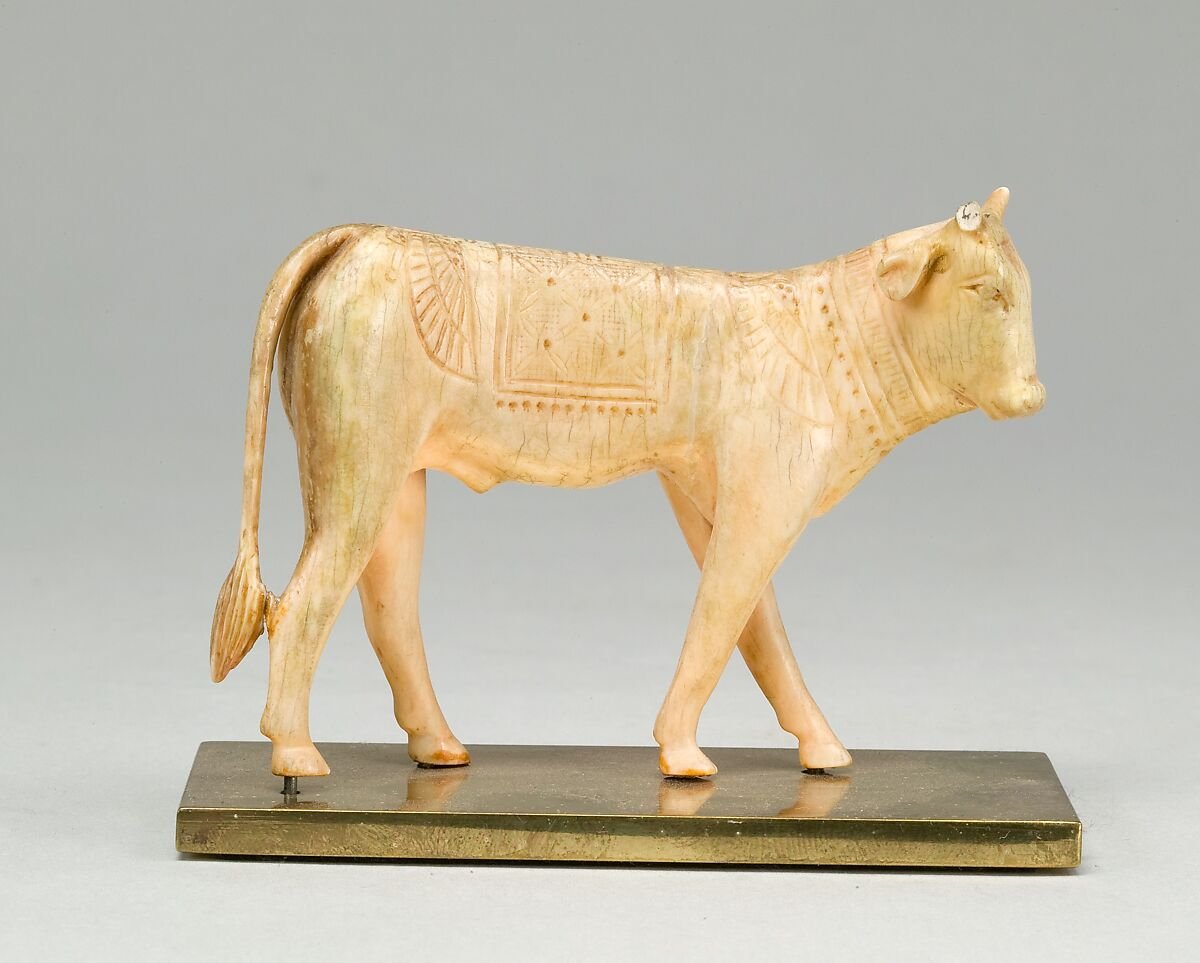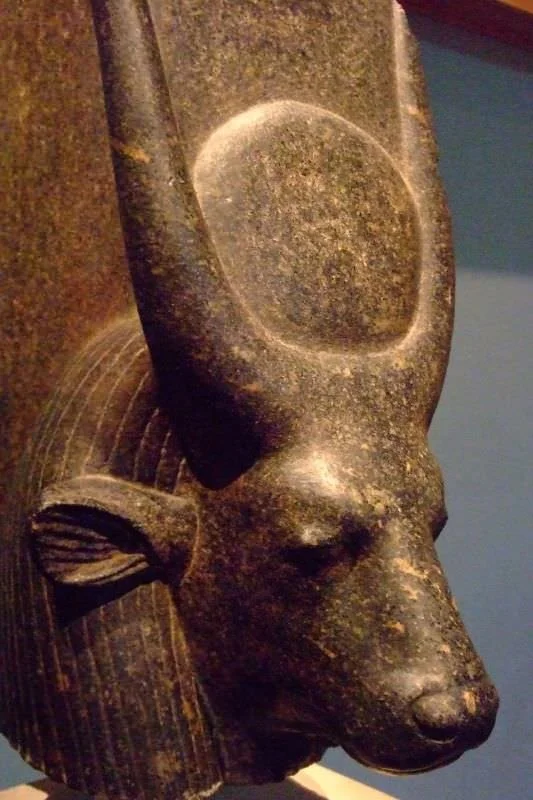Was the Golden Calf an Apis Bull?
In the Bible comic, I now need to draw the Golden Calf of Exodus 32. I’ve thought for a long time that this would be an Apis Bull so I did some research into whether this is actually likely…
What is an Apis Bull
Coffin painting of and Apis Bull. c. 11th century B.C. Public Domain.
The Apis was a live bull that was considered to be a sort of physical incarnation of the god Ptah; the "soul of Ptah" or "herald of Ptah, kept in the temple of Ptah, in Memphis. The bull was, therefore, a kind of servant or intermediary, who was itself divine. It was revealed to the populace in a procession and its movements were interpreted as oracles and were thought to reflect the responses of Ptah. It was fed the best foods, slept on luxurious bedding, given hot baths, massaged, and perfumed and upon its death, the body was embalmed, and then solemnly interred in the temple of Serapis at Memphis.
The Apis is usually depicted as a black bull a sun disk between his horns and an uraeus snake emerging before the disk.
The Apis is described by the Greek researcher Herodotus:
The Apis is the calf of a cow which is never afterwards able to have another. The Egyptian belief is that a flash of light descends upon the cow from heaven, and this causes her to conceive Apis. The Apis-calf has distinctive marks: it is black, with a white square [or triangle] on its forehead, the image of an eagle on its back, the hair on its tail double, and a scarab under its tongue.
(More info on Apis : https://www.virtual-egyptian-museum.org/Collection/FullVisit/Collection.FullVisit-JFR.html?../Content/MET.LL.00887.html&0 )
Was the Golden Calf an Apis?
I think the key thing to remember is that the Israelites had lived in Egypt for generations, the people Moses lead might have been genetically Hebrew, but they were also Egyptian nationals through and through. Some of the multitudes that left of the Exodus were even non-Jewish (Exodus 12:38).
When the people thought they’d lost Moses, they turned back to their old ways. I do not believe they plucked the idea of a bull out of thin air or as a lottery, it was something they already knew.
On this website “Why a Golden Calf and not any other symbol?” Jonathan Frankel writes:
There were other Egyptian and Canaanite bull cults, e.g. Buchis, Mnevis, El, which could have been the inspiration for the Golden Calf, however, the specific chronicity, procedures and celebrations of the Apis Calf are highly suggestive that it was the motivation behind the Golden Calf. Moshe [Moses] had been on Har Sinai for 40 days and presumed dead and the Golden Calf arrived on the 40th day, just as an Apis Calf is prepared and revealed after 40 days following the death of its predecessor. The calf was made of gold, just as the Apis Calf arrived at the temple in a golden cabin. The people wanted an intermediate to serve between them and god, so Aharon created for them the religious entity they were familiar with in Egypt that served as an intermediate between them and god. And just as the Egyptians would celebrate the arrival of a new Apis Calf, so too the Israelites celebrated the arrival of their new intermediary.
Next is the statement which is the source of the above statements:
“Since the Apis Bull was a living creature, it would eventually die, prompting… the search for a new Apis bull…. This new Apis would be a calf…. they took it to Nilopolis for 40 days of feeding after which time it was transferred via a boat inside a gold cabin to the temple of Ptah where it was greeted by the people who came to view their reincarnated god and hoped to have their questions answered.” (A Popular Account of the Ancient Egyptians: Volume 1: John Gardner Wilkinson)
As these elements pertain to a living bull, if the Golden calf was a statue (see below) it would not have been able to move, but this may have been the symbolic significance.
If they viewed the Golden Calf as a sort of reincarnation of Moses (whom they presumed dead) and a divine entity then it makes a little more sense of the statement said about the Golden Calf “Then they said, ‘These are your gods, Israel, who brought you up out of Egypt.’” (Exodus 32:4b)
Examples of Apis Bull statues are evident in this era (the example below is from within approx 50 years of the Exodus).
Looking at many commentaries and Archaeological study bibles most seem to land on the opinion that the Golden calf was “most likely” an Apis Bull.
I made my own mind up when I read a different website which struggled with the language used regarding Aarons's creation of the bull. Exodus 32:4 is rendered in the NIV “He took what they handed him and made it into an idol cast in the shape of a calf, fashioning it with a tool.”
How exactly did Aaron form this calf? The only other use of the word cheret suggests that it means a stylus:
ישעיה ח:א וַיֹּאמֶר יְ־הוָה אֵלַי קַח לְךָ גִּלָּיוֹן גָּדוֹל וּכְתֹב עָלָיו בְּחֶרֶט אֱנוֹשׁ. : Isa 8:1 Then the Lord said to me, “Get yourself a large sheet and write on it with a human stylus” (my translation).
Some translations rendered it in Exodus according to this meaning:
- LXX: “formed them with a graving tool” (ἔπλασεν αὐτὰ ἐν τῇ γραφίδι);
- Onkelos: וְצָר יָתֵיהּ בְּזִיפָא, “and he formed it with a chisel,”
- Martin Luther’s 1545 translation: “designed it with a stylus” (entwarf's mit einem Griffel),
- King James (KJV): “fashioned it with a graving tool.”
I think this detail of this engraving tool/stylus in the language which translators struggle to conceive of as useful in moulding a golden sculpture is actually a big conformation of the gold calf being an Apis, to my mind.
Look closely at the idol and the engraved patterns around the neck, the eagle over the shoulders and flanks, the blanket and other lines. (Also on the idol from c. 1400 BC above)
Apis Bull Figure: (525–332 BC) (Public Domain image)
Who is Ptah
Ptah (Public domain)
The fact that the Apis is connected to Ptah is an additional reason why the connection makes sense. As I mentioned above, the Israelite people were Egyptian nationals born and bred, and their understanding of YHWH was likely coloured by the national religion of the Egyptian pantheon, or at the very least they might think about which of the pantheon of gods would most equate to YHWH. So who was Ptah?
Wikipedia states it succinctly:
Ptah is an Egyptian creator god who conceived the world and brought it into being through the creative power of speech. A hymn to Ptah dating to the Twenty-second Dynasty of Egypt says Ptah "crafted the world in the design of his heart," and the Shabaka Stone, from the Twenty-Fifth Dynasty, says Ptah "gave life to all the gods and their kas [souls] as well, through this heart and this tongue." […]
Epiphets: Ptah the begetter of the first beginning, Ptah lord of truth, Ptah lord of eternity, Ptah who listens to prayers, Ptah master of ceremonies, Ptah master of justice.
As the pre-existent creator god and lord of truth and justice, you can imagine how the Israelites would equate him with YHWH. If they did and sort a new intermediary between them and God then following the pattern for Ptah is somewhat understandable.
What if the Golden Calf was alive?
I also wondered if it is possible that the Golden Calf could have been a living Apis bull. I.e. a living calf dressed up in golden finery or a golden covering perhaps. Looking at the verses it all seems very possible except for Exodus 32:4 which says it is moulded and 32:24 where Aaron says (stupidly) he put the gold in the fire and the calf came out. So it doesn’t seem that the text can support a living Apis Bull in gold.
Other Ideas
Invisible God: Some scholars suggest the calf was merely a pedestal or mount, as other idols are depicted atop a bull. The idea was that the golden calf was a pedestal for an invisible God. This however doesn’t seem consistent with the language used about the idol and the reaction of Moses and God to its creation. If the Golden Bull was supposed be a divine intermediary replacing Moses and telling them the will of YHWH, then the reaction does fit well.
Hathor: Another option was that the idol was dedicated to Hathor. Hathor is another deity of Egypt that was popular at the time, who was portrayed at times as a woman with a cow’s head, or cow-like features (horns, cow ears), and sometimes as a cow. However her candidacy seems less likely as the golden idol is named a “calf” (עֵגֶל) or the masculine noun 'egel', denoting a young male calf and not the female cow which symbolises her.
Hathor was believed to be a goddess of beauty, sensuality, music, dancing, and maternity and mother to Horus and Ra, which is not as close a fit to YHWH as Ptah, and therefore a less likely crossover.
Additionally, one thing that would favour the Apis over Hathor is the geographical centre of their cults. The centre of worship for the Apis was Memphis in the north (where the Israelites were in Goshen), whereas Hathor worship had its centre around Dendera in the far south of Egypt.
Hathor Dendera Temple (Public Domain Image)
Conclusion
For the reasons stated of the connection to Ptah, the people’s desire for a new intermediary, the engraving work on the statue and the cultural connections I think it is very likely that what they created was an idol statue of an Apis Bull.
Here is an early drawing I created for Acts 7: 40-41
If you like the Word for Word Bible Comic and want to support the project why not consider becoming a patron! From just $1 a month you can really help!











